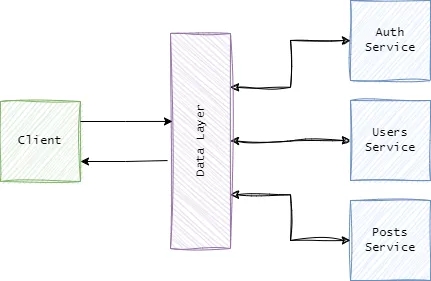In this post, I will be looking at microservices and monolithic development for application services. What are the advantages of both, when would we use one over the other, and what factors impact this decision.
In the realm of software development, choosing the right architecture is akin to laying the foundation of a building. It sets the stage for how your application will evolve, scale, and adapt to changing requirements. Two prevalent paradigms in this domain are Microservices and Monolithic architectures. Let’s delve into what each entails, their respective advantages, and when to employ them.
Monolithic architecture
A monolithic architecture refers to an application that is built as a single, indivisible unit. In this model, all the components, functionalities, and services are tightly integrated and interact within a single codebase.

In the Microsoft Azure world, you could still deploy a monolithic web application to a PaaS service, such as Azure App Service. The target model does not dictate that your solution is either cloud native, or following a different architecture pattern.
Here are some of the advantages of a monolithic architecture.
- Simplicity of development – Since all components are in one place, it’s easier for developers to understand the entire system. This simplifies the development process, especially for smaller applications.
- Easier to debug and test – Debugging and testing processes are streamlined as all modules are within the same codebase. This enables quicker identification and resolution of issues.
- Simplified deployment – Deploying a monolithic application is straightforward as you only need to deploy a single unit. There are no complex orchestration requirements.
- Performance – Monolithic applications often have lower overhead due to their simplified architecture, resulting in faster execution.
- Simple scaling – When the application requires more resources, you can scale it vertically by increasing the power of the server.
Of course some of the points here are a little subjective, with the right focus on continuous integration, and continuous deployment, you could find your microservices easier to deploy, and with the right testing regime it could also be easy to test microservices. But these all require a time investment and that’s where these statements come from.
When to use a monolithic architecture
The key question is when would you use a monolithic architecture? Three key reasons spring to mind:
- Simple applications – Monolithic architectures are well-suited for smaller applications with straightforward functionalities.
- Rapid prototyping – For proof of concepts or projects with tight deadlines, a monolithic architecture allows for quicker development.
- Limited resources – When resources are limited, having a single codebase can be more manageable.
Microservices architecture
Microservices architecture is an approach where an application is built as a collection of loosely coupled, independently deployable services. Each service represents a specific business capability and communicates with others through APIs.
Some of the advantages of using a microservice architecture are listed below.
- Modularity and scalability – Microservices allow for independent development, deployment, and scaling of services. This modularity is excellent for handling complex and evolving applications.
- Technological diversity – Different services can be written in different languages or use different technologies, allowing you to choose the best tool for each specific task.
- Resilience and fault isolation – If one service fails, it doesn’t necessarily bring down the entire application. Services can be designed to be resilient and fail gracefully.
- Team autonomy – Different teams can work on different services, allowing for parallel development and deployment.
- Easier integration of third-parties – It’s simpler to integrate third-party services or APIs into a microservices-based system due to the loosely coupled nature.
When to use microservices architecture
Here are some of the headline reasons you would use a microservice architecture.
- Complex applications – Microservices shine in complex systems with many interacting components.
- Large development teams – When multiple teams work on different parts of an application, microservices enable them to operate independently.
- Scalability – Applications that need to scale dynamically based on specific services benefit from the flexibility offered by microservices.
- Software as a service – When developing a SaaS application, microservices are a great development model due to the reasons listed above.
GraphQL APIs
I want a special mention here for GraphQL APIs, after my post looking at GraphQL and REST in .NET, it got me thinking. Does the microservices pattern work with GraphQL, which is designed to be a single endpoint?
Well, if we look at the traditional use of microservices, where every service in an API endpoint, then this does break the benefits of GraphQL, such as the single endpoint, and the ability to query multiple resources in one query. You could of course enable this functionality in your APIs, but then this would get very complex and add dependencies to otherwise disconnected services.
What if we thought about it from a different perspective? What if we used GraphQL as a data layer?
GraphQL can solve this problem for monolith APIs based on REST and for a microservice architecture when it’s implemented as a data layer. With GraphQL, you can construct a query to retrieve both the user and posts of that user in one request. The API data layer will send the correct requests to the microservices for users and posts and stitch the data into one response.

Take the above diagram. It hides the underlying microservice structure, can be used to create a single endpoint for all your microservices, and the experience for those consuming the APIs is simple. Besides this, GraphQL also comes with a rich ecosystem of tooling that you can use on your client(s) to interact with the API data layer through GraphQL. Combining all these requests can lead to increased response time, but this cost is often insignificant.
A drawback of the data layer pattern is the increased complexity it brings with it. The data layer needs to be built, maintained, and deployed when the underlying microservices are updated. Building this can be very time-consuming for smaller teams.
So in summary, it does break the traditional pattern, but you can use a data layer to combat this, it just adds complexity. Another design decision you have to make as a team.
Factors impacting the decision
With all this information, how do you decide which architecture you should be using? Here are some pointers which may help you decide.
- Project size and complexity – Smaller, simpler projects might find monolithic architecture more suitable, while larger, more complex projects benefit from the modularity of microservices.
- Team structure – A well-organized, skilled development team can manage the intricacies of microservices, while smaller or less experienced teams might find monolithic architectures more manageable.
- Resource constraints – Limited resources might favour the simplicity of monolithic architectures, whereas well-resourced teams can harness the power of microservices.
- Future growth and evolution – Consider how the application might evolve over time. If rapid development and adaptation are crucial, microservices offer greater flexibility.
Summary
In conclusion, choosing between microservices and monolithic architecture is not a one-size-fits-all decision. It requires careful consideration of the project’s requirements, team capabilities, and future expectations. Both paradigms have their strengths, and understanding their nuances empowers you to make the best architectural choice for your specific scenario.

One thought on “Architecting for the Modern Cloud: Microservices vs Monolithic”